
Signatures of Quantum-like Chaos in Dow Jones
Index and Turbulent Fluid Flows
A. M. Selvam
(Retired) Indian Institute of Tropical Meteorology,
Pune 411 005, India
Abstract
Dow Jones Index time series exhibit irregular
or fractal fluctuations on all time scales from days, months to
years. The apparently irregular (nonlinear) fluctuations are selfsimilar
as exhibited in inverse power law form for power spectra of temporal (spatial)
fluctuations. Inverse power law form for power spectra of fractal
fluctuations is generic to all spacially extended dynamical systems in
nature and is identified as self-organized criticality. Selfsimilarity
implies long-range space-time correlations or non-local connections. It
is important to quantify the total pattern of fractal fluctuations
for predictability studies, e.g., weather and climate prediction, stock
market trends, etc. The author has developed a general systems theory for
universal quantification of the observed self-organized criticality
in dynamical systems. The model predictions are as follows. (1) The power
spectra of fractal fluctuations follow the universal and unique
inverse power law form of the statistical normal distribution. (2) The
non-local connections or long-range correlations exhibited by the fractal
fluctuations are signatures of quantum-like chaos in macroscopic spatially
extended dynamical systems. (3) The apparently irregular geometry of the
fractal
fluctuations forms the component parts of a unified whole precise
geometrical pattern of the logarithmic spiral with quasiperiodic
Penrose
tiling pattern for the internal structure. Conventional power spectral
analyses will resolve the logarithmic spiral pattern as an eddy continuum
with progressive increase in eddy phase angle. (4) The eddy continuum exhibit
dominant periodicities which are functions of the golden mean (@
1.618) and the numerical value T of the primary perturbation time
period (days, months years). The numerical values of the first 13
dominant cycles for unit time scale (days, months or years) for the primary
perturbation time period, i.e., T = 1, are 2.2,
3.6,
5.8,
9.5,
15.3,
24.8,
40.1,
64.9,
105.0,
170.0,
275.0,
445.0, 720.0 . These dominant periodicities are robust cycles
inherent to dynamical systems and are independent of all other factors
except the numerical value of the primary perturbation cycle time period
T.
Examples of persistent primary perturbation cycles in nature are, the daily
cycle of solar heating of atmospheric flows, the day- to- day stock market
trading cycle, etc . (5) Periodicities up to about 3.6 time scale
units (days, months or years) contribute up to 50% of the total variance.
Continuous periodogram
power spectral analyses of normalised daily, monthly and annual Dow Jones
Index for the past 100-years show that the power spectra follow the universal
inverse power law form of the statistical normal distribution in agreement
with model prediction. The fractal fluctuations of Dow Jones Index therefore
exhibit self-organized criticality which is a signature
of quantum-like chaos on all time scales from days to years. All the data
sets exhibit periodicities close to model predicted values of about 2.2,
3.6, etc., time units in days, months, years respectively for data sets
of daily, monthly and annual values. Also 50% contribution to total
variance is contributed by periodicities up to the model predicted
value of about 3.6 time units in days, months, years.
The apparently noisy, irregular fractal fluctuations of dynamical
systems such as the Dow Jones Index in the present study, contribute to
the formation of robust selfsimilar space-time geometrical structures which
indicate the surprising resilience of market economy over a period of 100
years.
1. Introduction
Irregular (nonlinear) fluctuations
on all scales of space and time are generic to dynamical systems in nature
such as fluid flows, atmospheric weather patterns, heart beat patterns,
stock market fluctuations, etc. Mandelbrot (1977) coined the name fractal
for the non-Euclidean geometry of such fluctuations which have fractional
dimension, for example, the rise and susequent fall with time of the Dow
Jones Index traces a zig-zag line in a two-dimensional plane and therefore
has a fractal dimension greater than one but less than two. Mathematical
models of dynamical systems are nonlinear and finite precision computer
realisations exhibit sensitive dependence on initial conditions resulting
in chaotic solutions, identified as deterministic chaos. Nonlinear
dynamics and chaos is now (since 1980s) an area of intensive research
in all branches of science (Gleick, 1987). The fractal fluctuations
exhibit scale invariance or selfsimilarity manifested as the widely documented
(Bak, Tang, Wiesenfeld, 1988; Bak and Chen, 1989; 1991; Schroeder, 1991;
Stanley, 1995; Buchanan,1997) inverse power law form for power spectra
of space-time fluctuations identified as self-organized criticality
by Bak et al. (1987). The power law is a distinctive experimental
signature seen in a wide variety of complex systems. In economy it goes
by the name fat tails, in physics it is referred to as critical
fluctuations, in computer science and biology it is the edge of
chaos, and in demographics it is called Zip's law (Newman,
2000). Power-law scaling is not new to economics. The power law distribution
of wealth discovered by Vilfredo Pareto (1848-1923) in the 19th
century (Eatwell, Milgate and Newman, 1991) predates any power laws in
physics (Farmer, 1999). One of the oldest scaling laws in geophysics
is the Omori law (Omori, 1895). It describes the temporal distribution
of the number of aftershocks which occur after a larger earthquake (i.e.,
mainshock) by a scaling relationship.The other basic empirical seismological
law, the Gutenberg-Richter law (Gutenberg and Richter, 1944) is
also a scaling relationship, and relates intensity to its probability of
occurrence (Hooge et. al., 1994). Time series analyses of global
market economy also exhibits power-law behaviour ( Bak et al., 1992;
Mantegna and Stanley, 1995; Sornette et al., 1995; Feigenbaum and
Freund, 1995; Chen, 1996a,b; Stanley et al., 1996; Feigenbaum and
Freund, 1997a,b; Gopikrishnan
et al., 1999; Plerou
et al.,
1999; Stanley et al., 2000; Feigenbaum, 2001a,b) with possible multifractal
structure ( Farmer, 1999 ) and has suggested an analogy to fluid turbulence
(Ghasgaie
et al., 1996; Arneodo et al., 1998). The stock
market can be viewed as a self-organizing cooperative system presenting
power law distributions, large events in possible co-existence with synchronized
behaviour (Sornette
et al., 1995). Sornette et al. (1995)
also conclude that the observed power law represents structures similar
to 'Elliott waves' of technical analysis first introduced in the
1930s. It describes the time series of a stock price as made of different
waves,
these waves are in relation to each other through the Fibonacci
series. Sornette
et al. (1995) speculate that 'Elliott waves'
could be a signature of an underlying critical structure of the stock market.
Incidentally the
Fibonacci series represent a fractal tree-like
branching network of selfsimilar structures (Stewart, 1992). The commonly
found shapes in nature are the helix and the dodecahedron (Stoddart, 1988;
Muller and Beugholt,1996) which are signatures of selfsimilarity underlying
Fibonacci
numbers. The general systems theory presented in this paper shows (Section
2) that Fibonacci series underlies fractal fluctuations on
all space-time scales. Chen (1996b) has identified color chaos and persistent
cycles with characteristic period of around three to four years in time
series analyses of Standard and Poor stock price indices.
Historically,
basic similarity in the branching (fractal) form underlying the individual
leaf and the tree as a whole was identified more than three centuries ago
in botany (Arber,1950). The branching (bifurcating) structure of roots,
shoots, veins on leaves of plants, etc., have similarity in form to branched
lighting strokes, tributaries of rivers, physiological networks of blood
vessels, nerves and ducts in lungs, heart, liver, kidney, brain ,etc. (Freeman,
1987; 1989; Goldberger et al., 1990; Jean, 1994; ). Such seemingly
complex network structure is again associated with Fibonacci numbers
seen in the exquisitely ordered beautiful patterns in flowers and
arrangement of leaves in the plant kingdom (Jean, 1994; Stewart, 1995).
The identification of physical mechanism for the spontaneous generation
of mathematically precise, robust spatial pattern formation in plants will
have direct applications in all other areas of science (Mary Selvam, 1998).
The importance of scaling concepts were recognized nearly a century ago
in biology and botany where the dependence of a property
y on size
x
is usually expressed by the allometric equation
y=axb
where a and b are constants (Thompson,1963; Strathmann, 1990;
Jean, 1994; Stanley, Amaral, Buldyrev, Goldberger et al.,
1996). This type of scaling implies a hierarchy of substructures and was
used by D’Arcy Thompson for scaling anatomical structures, for example,
how proportions tend to vary as an animal grows in size (West, 1990a).
D’Arcy
Thompson (1963, first published in 1917) in his book
On Growth and
Form has dealt extensively with similitude principle for biological
modelling. Rapid advances have been made in recent years in the fields
of biology and medicine in the application of scaling (fractal)
concepts for description and quantification of physiological systems and
their functions (Goldberger, Rigney and West, 1990; West, 1990a,b; Deering
and West,1992; Skinner,1994; Stanley, Amaral, Buldyrev, Goldberger
et.
al.,
1996). In meteorological theory, the concept of selfsimilar fluctuations
was identified and introduced in the description of turbulent
flows by Richardson (1965, originally published in 1922; see also Richardson,
1960), Kolmogorov (1941,1962), Mandelbrot (1975) (Kadanoff 1996) and others
(see Monin and Yaglom ,1975 for a review).
Self-organized criticality
implies long-range space-time correlations or non-local connections in
the spatially extended dynamical system. The physics underlying self-organized
criticality is not yet identified. Prediction of the future evolution
of the dynamical system requires precise quantification of the observed
self-organized
criticality. The author has developed a general systems theory
(Capra, 1996 ) which predicts the observed self-organized criticality
as a signature of quantum-like chaos in the macro-scale dynamical system
(Mary Selvam, 1990; Mary Selvam, Pethkar and Kulkarni, 1992; Selvam and
Fadnavis, 1998). The model also provides universal and unique quantification
for the observed
self-organized criticality in terms of the statistical
normal distribution.
Continuous periodogram
power spectral analyses of Dow Jones Index time series of widely different
time scales (days, months, years) and data lengths (100 to 10000 in the
case of daily data sets) agree with model prediction, namely, the power
spectra follow the universal inverse power law form of the statistical
normal distribution. Dow Jones Index time series therefore exhibit self-organized
criticality which is a signature of quantum-like chaos. Earlier studies
by the author have identified quantum-like chaos exhibited by dynamical
systems underlying the observed fractal fluctuations of the following data
sets: (1) time series of meteorological parameters (Mary Selvam, Pethkar
and Kulkarni,1992; Selvam and Joshi, 1995; Selvam et al.,1996; Selvam
and Fadnavis, 1998). (2) spacing intervals of adjacent prime numbers
(Selvam and Suvarna Fadnavis, 1998; Selvam, 2001a) (3) spacing intervals
of adjacent non-trivial zeros of the Riemann zeta function (Selvam, 2001b)
2. A General Systems Theory
for Universal Quantification of Fractal Fluctuations of Dynamical Systems
As mentioned earlier (Section 1: Introduction)
power spectral analyses of fractal space-time fluctuations exhibits
inverse power law form, i.e., a selfsimilar eddy continuum. The
cell
dynamical system model (Mary Selvam, 1990; Selvam and Fadnavis, 1998,
and all references contained therein; Selvam, 2001a, b) is a general systems
theory (Capra, 1996) applicable to dynamical systems of all size scales.
The model shows that such an eddy continuum can be visualised as a hierarchy
of successively larger scale eddies enclosing smaller scale eddies. Eddy
or wave is characterised by circulation speed and radius. Large eddies
of root mean square (r.m.s) circulation speed
W and radius
R
form as envelopes enclosing small eddies of r.m.s circulation speed w*
and radius
r such that

(1)
Large eddies are
visualised to grow at unit length step increments at unit intervals of
time, the units for length and time scale increments being respectively
equal to the enclosed small eddy perturbation length scale r
and the eddy circulation time scale t .
Since the large eddy
is but the average of the enclosed smaller eddies, the eddy energy spectrum
follows the statistical normal distribution according to the Central
Limit Theorm (Ruhla, 1992). Therefore, the variance represents the
probability densities. Such a result that the additive amplitudes of the
eddies, when squared, represent the probabilities is an observed feature
of the subatomic dynamics of quantum systems such as the electron or photon
(Maddox 1988a, 1993; Rae, 1988 ). The fractal space-time fluctuations
exhibited by dynamical systems are signatures of quantum-like mechanics.
The cell dynamical system model provides a unique quantification for the
apparently chaotic or unpredictable nature of such fractal fluctuations
( Selvam and Fadnavis, 1998). The model predictions for quantum-like chaos
of dynamical systems are as follows.
(a) The observed fractal fluctuations of dynamical
systems are generated by an overall logarithmic spiral trajectory with
the quasiperiodic Penrose tiling pattern (Nelson, 1986; Selvam and
Fadnavis, 1998) for the internal structure.
(b) Conventional continuous periodogram power spectral
analyses of such spiral trajectories will reveal a continuum of periodicities
with progressive increase in phase.
(c) The broadband power spectrum will have embedded
dominant wave-bands, the bandwidth increasing with period length. The peak
periods (or length scales) En in the dominant
wavebands will be given by the relation
En=Ts(2+t
)t n
(2)
where t
is the golden mean equal to (1+Ö
5)/2 [@ 1.618]
and Ts , the primary perturbation length scale.
Considering the most representative example of turbulent fluid flows, namely,
atmospheric flows, Ghil(1994) reports that the most striking feature in
climate variability on all time scales is the presence of sharp peaks superimposed
on a continuous background.
The model predicted periodicities
(or length scales) in terms of the primary perturbation length scale units
are are 2.2,
3.6,
5.8,
9.5,
15.3,
24.8,
40.1,
64.9,
105.0,
170.0,
275.0,
445.0
and
720.0 respectively for values of n
ranging from -1 to 11. Peridicities close to model predicted have
been reported in weather and climate variability (Burroughs 1992; Kane
1996).
(d) The ratio r/R also represents the
increment dq
in phase angle q
(Equation 1 ). Therefore the phase angle q
represents the variance. Hence, when the logarithmic spiral is resolved
as an eddy continuum in conventional spectral analysis, the increment in
wavelength is concomitant with increase in phase (Selvam and Fadnavis,
1998). Such a result that increments in wavelength and phase angle are
related is observed in quantum systems and has been named 'Berry's phase'
(Berry 1988; Maddox 1988b; Simon et al., 1988; Anandan, 1992). The
relationship of angular turning of the spiral to intensity of fluctuations
is seen in the tight coiling of the hurricane spiral cloud systems.
The overall logarithmic spiral flow structure is
given by the relation

(3)
where the constant k is the steady
state fractional volume dilution of large eddy by inherent turbulent eddy
fluctuations . The constant k is equal to 1/t2(@0.382)
and is identified as the universal constant for deterministic chaos in
fluid flows (Selvam and Fadnavis, 1998).The steady state emergence of fractal
structures is therefore equal to
1/k @2.62
(4)
The model predicted logarithmic
wind profile relationship such as Equation 4 is a long-established (observational)
feature of atmospheric flows in the atmospheric boundary layer, the constant
k,
called the Von Karman ’s constant has the value equal to
0.38
as determined from observations (Wallace and Hobbs, 1977).
In Equation 3, W
represents the standard deviation of eddy fluctuations, since W
is computed as the instantaneous r.m.s. ( root mean square) eddy perturbation
amplitude with reference to the earlier step of eddy growth. For two successive
stages of eddy growth starting from primary perturbation w*
the ratio of the standard deviations Wn+1 and
Wn
is given from Equation 3 as (n+1)/n. Denoting by s
the standard deviation of eddy fluctuations at the reference level (n=1)
, the standard deviations of eddy fluctuations for successive stages of
eddy growth are given as integer multiple of s
, i.e., s
, 2s
, 3s
, etc., and correspond respectively
to
statistical normalized standard deviation
t=0,1,2,3,
etc.
(5)
The conventional
power spectrum plotted as the variance versus the frequency in log-log
scale will now represent the eddy probability density on logarithmic scale
versus the standard deviation of the eddy fluctuations on linear scale
since the logarithm of the eddy wavelength represents the standard deviation,
i.e., the r.m.s. value of eddy fluctuations (Equation 3). The r.m.s. value
of eddy fluctuations can be represented in terms of statistical normal
distribution as follows. A normalized standard deviation t=0
corresponds to cumulative percentage probability density equal to 50
for the mean value of the distribution. Since the logarithm of the wavelength
represents the r.m.s. value of eddy fluctuations the normalized standard
deviation t is defined for the eddy energy as

(6)
where L is the period in years
and
T50 is the period up to which the cumulative
percentage contribution to total variance is equal to 50
and t = 0. The variable
logT50 also
represents the mean value for the r.m.s. eddy fluctuations and is consistent
with the concept of the mean level represented by r.m.s. eddy fluctuations.
Spectra of time series of fluctuations of dynamical systems, for example,
meteorological parameters, when plotted as cumulative percentage contribution
to total variance versus
t follow the model predicted
universal spectrum (Selvam and Fadnavis, 1998, and all references
therein). The literature shows many examples of pressure, wind and temperature
whose shapes display a remarkable degree of universality (Canavero and
Einaudi,1987).
The periodicities (or length scales)
T50
and T95 up to which the cumulative percentage
contribution to total variances are respectively equal to 50
and 95 are computed from model concepts as follows.
The power spectrum, when plotted
as normalised standard deviation t versus cumulative
percentage contribution to total variance represents the statistical normal
distribution (Equation 6), i.e., the variance represents the probability
density. The normalised standard deviation values t corresponding
to cumulative percentage probability densities P equal to
50 and 95 respectively are equal to 0
and 2 from statistical normal distribution characteristics.
Since t represents the eddy growth step n (Equation
5) the dominant periodicities (or length scales) T50
and T95 up to which the cumulative percentage
contribution to total variance are respectively equal to 50
and 95 are obtained from Equation 2 for corresponding values
of n equal to 0 and 2. In the
present study of fractal fluctuations of Dow Jones Index, the primary
perturbation length scale Ts is equal to unit
time interval (days, months or years) and T50
and T95 are obtained as
T50 = (2+t
)t0 @
3.6 unit time interval
(7)
T95 = (2+t
)t2 @
9.5 unit time interval
(8)
The above model
predictions are applicable to all real world and computed model dynamical
systems. Continuous periodogram power spectral analyses of Dow Jones Index
of widely different time scales and data lengths give results in agreement
with the above model predictions.
3. Data and Analysis
Dow Jones Index values were obtained from
Dow Jones Industrial Average History File, Dow Jones closing prices starting
in 1900: 3 Jan 1900 to 5 June 2000 (27523 trading days). Data from: Department
of Statistics at Carnegie Mellon Univ., (http://www.stat.cmu.edu/cmu-stats)
Quote.com (http://quote.com) Yahoo! (http://quote.yahoo.com).
The normalised day- to- day changes in the Dow Jones Index values were
computed as percentages of the earlier day value. Monthly and annual mean
values were then computed from the normalised day- to- day changes
in the Dow Jones Index. A total of 27,500 daily values of normalised Dow
Jones Index were used for the study. Starting from the Dow Jones Index
values on day numbers 1, 10001, and 20001 respectively, the number of days
used for the spectral analyses were in increments of 100 days up to 2500
days (25 data sets) and thereafter, in increments of 500 days till 10000
days (15 data sets) giving a total of 115 data sets. A total of 1200
monthly mean values of Dow Jones Index were available for the study. A
total of 11 data sets were subjected to spectral analyses. Starting from
the first month, the number of months used for the spectral analyses for
the first 10 data sets were in increments of 100 months till 1000 months
and the 11th data set contains 1200 months. A total of 100 annual
mean Dow Jones Index values were available for the study. Power spectral
analyses were done for 5 data sets. Starting from the first year, the number
of years used for the 5 data sets were in increments of 20 years.
3.1 Fractal Nature of Dow
Jones Index Fluctuations on time scales of days to years
The normalised daily, monthly and annual fluctuations
of Dow Jones Index exhibit irregular fractal fluctuations
as shown for representative data sets in in Figure 1.
Figure 1: Fractal fluctuations
of normalised daily, monthly and annual fluctuations in Dow Jones Index
for the 100-year (1900 to 1999) data set
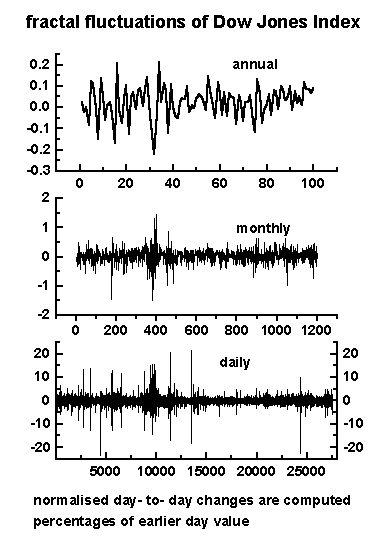
3.2 Continuous Periodogram
Power Spectral Analyses
The broadband power spectrum of space-time
fluctuations of dynamical systems can be computed accurately by an elementary,
but very powerful method of analysis developed by Jenkinson (1977) which
provides a quasi-continuous form of the classical periodogram allowing
systematic allocation of the total variance and degrees of freedom of the
data series to logarithmically spaced elements of the frequency range (0.5,
0).
The periodogram is constructed for a fixed set of 10000(m)
periodicities Lm which increase geometrically
as Lm=2 exp(Cm) where
C=.001 and
m=0,
1, 2,....m . The data series
Yt for the
N
data points was used. The periodogram estimates the set of Amcos(2pnmS-fm)
where Am, nm
and fm
denote respectively the amplitude, frequency and phase angle for the mth
periodicity and S is the time interval in days, months or
years. The cumulative percentage contribution to total variance was computed
starting from the high frequency side of the spectrum. The period T50
at which 50% contribution to total variance occurs is taken as reference
and the normalized standard deviation tm values
are computed as (equation 6) .
tm = (log Lm
/ log T50)-1
The cumulative percentage
contribution to total variance, the cumulative percentage normalized phase
(normalized with respect to the total phase rotation) and the corresponding
t
values were computed. The power spectra were plotted as cumulative percentage
contribution to total variance versus the normalized standard deviation
t
as given above. The period
L is in time interval units (days,
months or years). Periodicities up to T50 contribute
up to
50% of total variance. The phase spectra were plotted as cumulative
percentage normalized (normalized to total rotation) phase .
3.3 Power Spectral Analyses:
Representative Variance and Phase Spectra
The variance and phase spectra along with
statistical normal distributions are shown in Figure 2 for
representative data sets of normalised daily, monthly and annual Dow Jones
Index. The 'goodness of fit' (statistical chi-square test) between the
variance spectra and statistical normal distribution is significant at
less than or equal to 5% level for all the daily and monthly spectra. In
the case of annual data sets, the variance spectra follows normal distribution
for all data sets except for the first set consisting of the first 20-years
(1900 to 1919). Phase spectra are close to the statistical normal
distribution, with the 'goodness of fit' being statistically significant
for all monthly and annual data sets and 66% of daily data sets. Further,
in all the cases, the 'goodness of fit' between variance and phase spectra
are statistically significant (chi-square test) for individual dominant
wavebands, in particular, for longer periodicities. A representative example
of daily data set is shown, where, though the phase spectrum does
not follow normal distribution (Figure 2), the phase and variance spectra
are the same in dominant wavebands ( Figure 3).
Figure 2: Representative spectra of
variance and phase along with statistical normal distribution for normalised
daily, monthly and annual fluctuations of Dow Jones Index. The variance
spectra for all data sets and phase spectra for monthly and annual data
sets follow the model predicted statistical normal distribution . The phase
spectrum does not follow the normal distribution for the sample daily
data set, but the variance and phase spectra are the same in individual
dominant eddies as shown in Figures 3 for the same data set
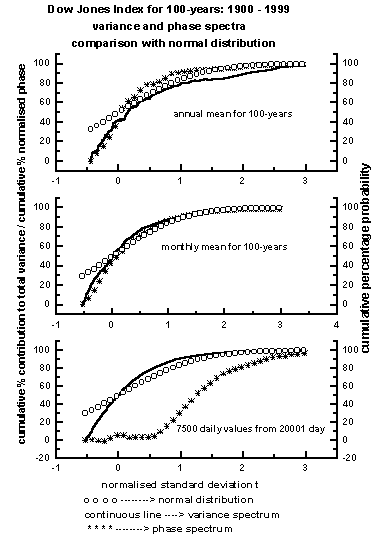
Figure 3: A representative example of
daily data set is shown, where, though the phase spectrum
does not follow normal distribution (Figure 2), the phase and variance
spectra are the same in dominant wavebands as shown below.The variance
and phase spectra being the same is a signature of Berry's phase
in quantum systems
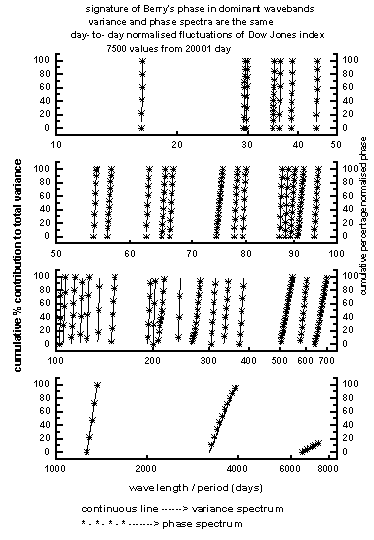
3.4 Power Spectral
Analyses: Summary of Results
The periodicities t50
up to which the cumulative percentage contribution to total variance is
equal to 50 are shown for the three groups of Dow Jones Index data
sets, namely, daily (115 data sets), monthly (11 data sets) and annual
(5 data sets) in Figures 4 (a, b and c) respectively.
Figure 4a: The period t50
up to which the cumulative percentage contribution to total variance is
equal to 50 for 115 data sets of normalised daily Dow Jones Index.
Details are also given of data set length, data mean and data standard
deviation
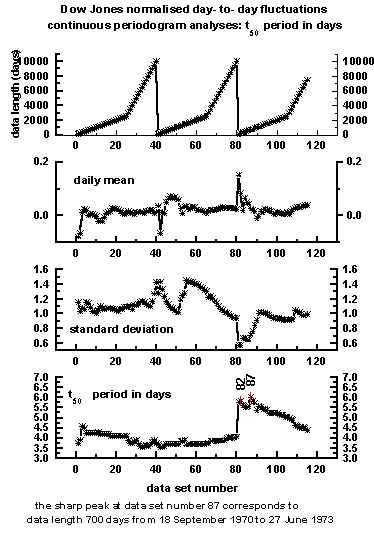
Figure 4b: The period t50
up to which the cumulative percentage contribution to total variance is
equal to 50 for 11 data sets of normalised monthly Dow Jones Index.
Details are also given of data set length, data mean and data standard
deviation
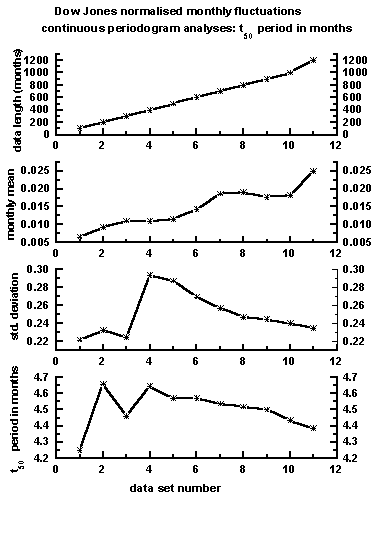
Figure 4c: The period t50
up to which the cumulative percentage contribution to total variance is
equal to 50 for 5 data sets of normalised annual Dow Jones Index.
Details are also given of data set length, data mean and data standard
deviation
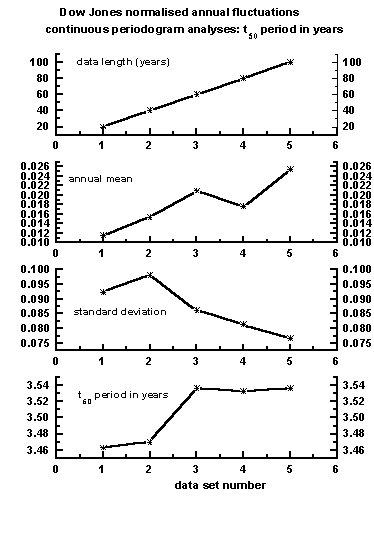
The power spectra exhibit
dominant wavebands where the normalised variance is equal to or greater
than 1. The dominant peak periodicities were grouped into class
intervals 2 - 3,
3 - 4, 4 - 6,
6 - 12,
12
- 20,
20 - 30, 30 - 50, 50 - 80, 80 - 120,
120
- 200, 200 - 300, 300 - 600, 600 - 1000, and greater
than 1000 . These class intervals include the model predicted (Equation
2) dominant peak periodicities (or length scales) 2.2,
3.6,
5.8,
9.5,
15.3,
24.8,
40.1,
64.9,
105.0,
170.0,
275.0,
445.0,
720.0,
(in days, months or years) for values of n ranging from -1
to 11. Class interval-wise percentage frequency of occurrence of dominant
periodicities were computed. In each class interval, the number of dominant
statistically significant (less than or equal to 5%) periodicities and
also the number of dominant wavebands which exhibit
Berry's phase
(variance and phase spectra are the same) are computed as percentages
of the total number of dominant wavebands in each class interval. The class
interval-wise mean and standard deviation of the above computed frequency
distribution of dominant periodicities, significant dominant periodicities
and dominant periodicities exhibiting
Berry's phase (see Section
2) were then computed for the three groups of data sets of daily (115 data
sets), monthly (11 data sets) and annual (5 data sets) Dow Jones Index
time series. The average class interval-wise distribution of dominant periodicities,
significant dominant periodicities and dominant periodicities exhibiting
Berry's
phase respectively are shown in Figures 5, 6 and 7.
Figure 5: Class interval-wise average
percentage frequency of occurrence of dominant periodicities for daily
(115 data sets), monthly (11 data sets) and annual (5 data sets) of normalised
Dow Jones Index
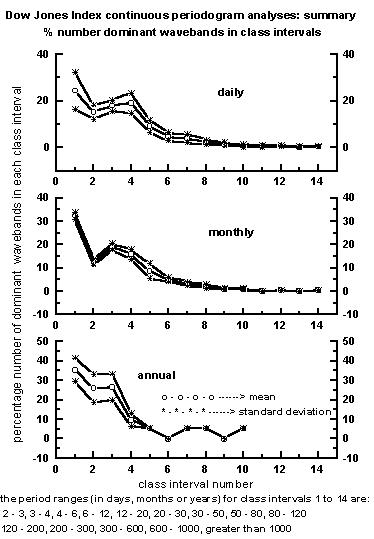
Figure 6: Class interval-wise average
percentage frequency of occurrence of significant dominant periodicities
for daily (115 data sets), monthly (11 data sets) and annual (5 data sets)
of normalised Dow Jones Index. The number of dominant statistically
significant (less than or equal to 5%) periodicities are computed as
percentages of the total number of dominant wavebands in each class interval.
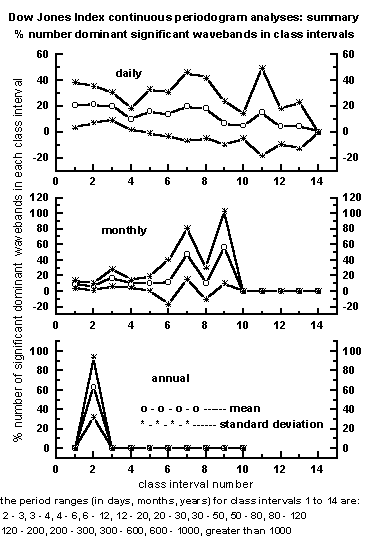
Figure 5c: Class interval-wise average
percentage frequency of occurrence of dominant wavebands which exhibit
Berry's
phase (variance and phase spectra are the same) for daily (115 data
sets), monthly (11 data sets) and annual (5 data sets) of normalised
Dow Jones Index. The number of dominant wavebands which exhibit Berry's
phase are computed as percentages of the total number of dominant
wavebands in each class interval
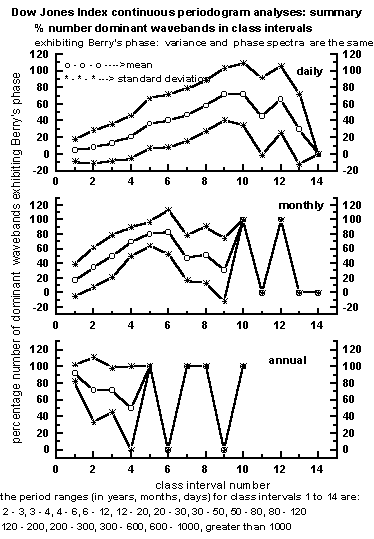
4. Results and Discussion
The Dow Jones Index time series (daily, monthly
and annual) exhibit fractal fluctuations (Figures 1a, b, c) generic
to dynamical systems in nature. The fractal fluctuations are basically
a zig-zag pattern of successive upward and downward swings on all time
scales in the Dow Jones Price Index. Such irregular fluctuations may be
visualised to result from the superimposition of a continuum of eddies.
Power spectral analysis is commonly applied to resolve the component periodicities
and their phases. Continuous periodogram power spectral analyses of the
fractal
fluctuations in Dow Jones Index time series (daily, monthly and annual)
follow closely the following model predictions given in Section 2.
(1) The variance spectra follow statistical
normal distribution for all the three (daily, monthly and annual) data
groups except for the first data set of length 20 years (1900 to 1919)
annual mean Dow Jones Index time series.
(2) Phase spectra follow normal distribution
for 66% of daily data sets and for 100% data sets of the monthly and annual
data groups.
(3) The period t50 up to
which the cumulative percentage contribution to total variance is equal
to 50% is very close to model predicted value of about 3.6 time units (daily,
monthly or annual) for annual and monthly data sets. The daily data sets
showed higher values for data set numbers 81 to 108. Incidentally these
data sets 81 to 108 correspond to the period just prior to and following
the oil shock of the year 1973 (Chen 1996a,b).Though the data length
varied from 100 to 10000 for daily data sets, the value of
t50
was relatively constant and close to the model predicted values (Figures
4a, b, c).
(4) The power spectra exhibit dominant wavebands
with peak periodicities close to model predicted values (Equation 2). The
average class interval-wise distribution of dominant and also dominant
significant peak periodicities for all the three data groups (Figures 5a,b;
6a,b; 7a,b) show a maximum for the shorter periodicities up to 4 - 6 time
units (days, months or years). This result is consistent with observed
and model predicted value of t50 equal to 3.6 time units
(equation ) as shown in item (3) above.
(5) Berry's phase (Section 2), namely, the
variance spectra following closely the phase spectra is exhibited for almost
all dominant wavebands for longer periodicities (Figures 5c; 6c; 7c) the
'goodness of fit' (chi-square test) being significant at less than or equal
to 5%.
Conclusions
The observed inverse power law form for power
spectra of fractal fluctuations is a signature of self-organized
criticality in dynamical systems. The author had shown earlier
(Selvam and Suvarna Fadnavis, 1998; selvam 2001a,b) that (a) self-organized
criticality can be quantified in terms of the universal inverse power
law form of the statistical normal distribution and (b) self-organized
criticality of selfsimilar fractal fluctuations implies long-range
space-time correlations and is a signature of quantum-like chaos in macro-scale
dynamical systems of all space-time scales.
Power spectra of normalised
daily, monthly and annual fluctuations of Dow Jones Index time series follow
the model predicted universal and unique inverse power law form of the
statistical normal distribution. Inverse power law form for power spectra
of temporal fluctuations imply long-range temporal correlations, or in
other words, persistence or long-term memory of short-term fluctuations.
The long-time period fluctuations carry the signatures of short-time period
fluctuations. The cumulative integration of short-term fluctuations generates
long-term fluctuations (eddy continuum) with two-way ordered energy feedback
between the fluctuations of all time scales (Equation 1 ). The eddy continuum
acts as a robust unified whole fuzzy logic network with global response
to local perturbations. Increase in random noise or energy input into the
short-time period fluctuations creates intensification of fluctuations
of all other time scales in the eddy continuum and may be noticed immediately
in shorter period fluctuations. Noise is therefore a precursor to signal.
Real world examples
of noise enhancing signal has been reported in electronic circuits (Brown,
1996). Man-made, urbanisation related, greenhouse gas induced global warming
(enhancement of small-scale fluctuations) is now held responsible for devastating
anomalous changes in regional and global weather and climate in recent
years (Selvam and Fadnavis, 1998).
Average class interval-wise
distribution of wavebandsgive the following results. (a) The periodicities
t50
up to which the cumulative percentage contribution to total variance is
equal to 50 are close to model predicted value of 3.6
for the data groups of widely different time scale units (days, months,
years) and different data lengths ( 100 to 10000 for daily data sets).
(b) A majority of dominant wavebands occur within the shorter period class
interval up to 5 time scale interval units consistent with observed and
model predicted value that periodicities up to 3.6 time interval
units alone contribute up to 50% of the total variance. (c) Variance
and phase spectra are the same (Berry's phase in quantum mechanics) in
a majority of dominant wave bands for larger periodicities. The dominant
wave bandwidth increases progressively with period length (Section 2).
The apparently irregular
fractal fluctuations of the Dow Jones Index as a representative example
in this study and dynamical systems in general, self-organize spontaneously
to generate the robust geometry of logarithmic spiral with the quasiperiodic
Penrose
tiling pattern for the internal structure. Conventional power spectral
analyses resolves such a logarithmic spiral geometry as an eddy continuum
with embedded dominant wavebands, the peak periodicities being functions
of the golden mean and the primary perturbation time scale. Power spectral
analyses of Dow Jones Index also exhibits the model predicted dominant
wavebands. These dominant periodicities are intrinsic to the selfsimilar
fractal fluctuations (space-time) of dynamical systems in general. Such
cycles are referred to as business cycles or endogeneous cycles in market
economics.
Acknowledgements
The author is grateful to Dr. A. S. R. Murty
for his keen interest and encouragement during the course of this study.
References
Anandan, J., 1992: The geometric phase. Nature
360, 307-313.
Arber, A.,1950: The Natural Philosophy
of Plant Form. Cambridge University Press, London.
Arneodo, A., Muzy, J.-F., and Sornette, D.,
1998: ‘Direct’ causal cascade in the stock market. European Physical
J. B Vol. 2, 277-282.
Bak, P., Tang, C. Wiesenfeld, K., 1987: Self-organized
criticality : an explanation of 1/f noise. Phys. Rev. Lett. 59,
381-384.
Bak, P.C., Tang, C., Wiesenfeld, K., 1988:
Self-organized criticality. Phys. Rev. A. 38, 364 - 374.
Bak, P., Chen, K., 1989: The physics of fractals.
Physica
D 38, 5-12.
Bak, P., Chen, K., 1991: Self-organized criticality.
Sci.
Am. Jan., 26-33.
Bak, P., Chen, K., Scheinkman, J. A., and
Woodford, M., 1992: Self-organized criticality and fluctuations in economics.
http://www.santafe.edu/sfi/publications/Abstracts/92-04-018abs.html
Berry, M. V.,1988: The geometric phase.
Sci.
Amer. Dec., 26-32.
Brown, J.,1996: Where two worlds meet. New
Scientist 18 May, 26-30.
Buchanan, M.,1997: One law to rule them all.
New
Scientist 8 Nov., 30-35.
Burroughs, W. J.,1992: Weather Cycles:
Real or Imaginary? Cambridge University Press, Cambridge.
Canavero, F. G., Einaudi, F.,1987: Time and
space variability of atmospheric processes. J. Atmos. Sci., 44(12),1589-1604.
Capra, F., 1996:The web of life.
Harper Collins, London, pp.311.
Chen, P., 1996a: Trends, shocks, persistent
cycles in evolving economy - business cycle measurement in
time-frequency representation, The Chapter 13 in Nonlinear Dynamics
and Economics, W.A. Barnett, A.P. Kirman, and M. Salmon eds. , Cambridge
University Press, Cambridge, UK.
Chen, P., 1996b: A random walk or color chaos
on the stock market? time-frequency analysis of S&P Indexes. Studies
in Nonlinear Dynamics and Econometrics, 1(2), 87-103. http://mitpress.mit.edu/e-journals/SNDE/001/articles/v1n2002.pdf
Deering, W., West, B. J., 1992: Fractal physiology.
IEEE
Engineering in Medicine and Biology, June, 40-46.
Eatwell, J., Milgate, M., and Newman,
P., 1991: The New Palgrave: A Dictionary of Economics 3, MacMillan
Press, London.
Farmer, J. D., 1999: Physicists attempt
to scale the ivory towers of finance. Computing in Science
& Engineering, November/December, 26-39. http://www.santafe.edu/sfi/publications/Abstracts/99-10-073abs.html
Feigenbaum, J. A., and Freund, P. G. O., 1997a:
Discrete scaling in stock markets before crashes.
http://xxx.lanl.gov/pdf/cond-mat/9509033
6 Sep 1995.
Feigenbaum, J. A., and Freund, P. G. O., 1997b:
Discrete scale invariance and the"second Black Monday".
http://xxx.lanl.gov/pdf/cond-mat/9710324
29 Oct 1997.
Feigenbaum, J. A., 2001a: A statistical analysis
of log-periodic precursors to financial crashes. http://xxx.lanl.gov/pdf/cond-mat/0101031
28 February 2001.
Feigenbaum, J. A., 2001b: More on a statistical
analysis of log-periodic precursors to financial crashes. http://xxx.lanl.gov/pdf/cond-mat/0107445
20 july 2001.
Freeman, G.R., 1987: Introduction. In: Freeman,
G.R. (ed.), Kinetics of Nonhomogenous Processes. John Wiley
and Sons, Inc., NY, pp. 1-18.
Freeman, G.R., 1990: KNP89: Kinetics of non
homogenous processes (KNP) and nonlinear dynamics. Can. J. Phys.,
68,
655-659.
Ghashghaie, S., Breymann, Peinke, J., Talkner,
P., Dodge, Y., 1996: Turbulent cascades in foreign exchange markets.
Nature,
381,
767-770.
Ghil, M.,1994: Cryothermodynamics: the chaotic
dynamics of paleoclimate. Physica D 77,130-159.
Gleick, J., 1987: Chaos : Making a New
Science. Viking , New York.
Goldberger, A. L., Rigney, D. R., West, B.
J., 1990: Chaos and fractals in human physiology. Sci. Am., 262(2),
42-49.
Gopikrishnan, P., Plerou, V., Amaral, L. A.
N., Meyer, M., Stanley, H. E., 1999: Scaling of the distribution of fluctuations
of financial market Indices.
http://xxx.lanl.gov/cond-mat/9905305.
Gutenberg, B., and Richter, R. F., 1944: Frequency
of earthquakes in California. Bull. Seis. Soc. Amer.,
34,
185.
Hooge, C., Lovejoy, S., Schertzer, D., Pecknold,
S., Malouin, J. F., Schmitt, F., 1994: Multifractal phase transitions:
the origin of self-organized criticality in earthquakes. Nonlinear Processes
in Geophysics 1,191-197.
Jenkinson, A. F.,1977: A Powerful Elementary
Method of Spectral Analysis for use with Monthly,Seasonal or Annual Meteorological
Time Series. Meteorological Office, London, Branch Memorandum No. 57,
pp. 1-23.
Jean R. V. 1994. Phyllotaxis : A Systemic
Study in Plant Morphogenesis, Cambridge University Press, NY, USA.
Kane, R. P., 1996: Quasibiennial and quasitriennial
oscillations in some atmospheric parameters. PAGEOPH 147(3),
567-583.
Levine, D., Steinhardt, J., 1984: Quasicrystals
: A new class of ordered structures. Phys.Rev.Letts., 53(26),
2477-2480.
Maddox, J., 1988a: Licence to slang Copenhagen
? Nature 332, 581.
Maddox, J., 1988b: Turning phases into frequencies.
Nature
334, 99.
Maddox, J., 1993: Can quantum theory be understood
? Nature 361, 493.
Mandelbrot, B. B., 1975: On the geometry of
homogenous turbulence with stress on the fractal dimension of the iso-surfaces
of scalars. J. Fluid Mech. 72, 401-416.
Mandelbrot, B. B., 1977: Fractals: Form,
Chance and Dimension. Freeman, San Francisco.
Mantegna, R. N., Stanley, H. E.,1995: Scaling
behaviour in the dynamics of an economic index. Nature 376,
46-49.
Mary Selvam, A., 1990: Deterministic chaos,
fractals and quantum-like mechanics in atmospheric flows. Canadian J.
Physics 68, 831-841. http://xxx.lanl.gov/html/physics/0010046
Mary Selvam, A., Pethkar, J. S., and Kulkarni,
M. K., 1992: Signatures of a universal spectrum for atmospheric interannual
variability in rainfall time series over the Indian Region. Int'l J.
Climatol. 12, 137-152.
Mary Selvam, A., 1998: Quasicrystalline pattern
formation in fluid substrates and phyllotaxis. In "Symmetry in Plants",
D. Barabe and R. V. Jean (Editors), World Scientific Series in Mathematical
Biology and Medicine, Volume 4., Singapore, pp.795-809.
http://xxx.lanl.gov/abs/chao-dyn/9806001
Muller, A., Beugholt, C.,1996: The medium
is the message. Nature 383, 296-297.
Nelson, D. R., 1986: Quasicrystals. Sci.
Amer. 255, 42-51.
Newman, M., 2000: The power of design.
Nature
405, 412-413.
Omori, F., 1895: On the aftershocks of earthquakes.
J.
Coll. Sci., 7, 111.
Plerou, V., Gopikrishnan, P., Amaral, L. A.
L., Meyer, M., Stanley, H. E., 1999: Scaling of the distribution
of price fluctuations of individual companies. http://xxx.lanl.gov/cond-mat/9907161.
Rae, A., 1988: Quantum-physics: illusion
or reality ? Cambridge University Press, New York, pp.129.
Richardson, L. F., 1960: The problem of contiguity:
an appendix to statistics of deadly quarrels. In: Von Bertalanffy, L.,
Rapoport, A.,(eds.) General Systems - Year book of the society for general
systems research, V, pp 139-187, Ann Arbor, MI.
Richardson, L. F.,1965: Weather Prediction
by Numerical Process. Dover, Mineola, N.Y.
Ruhla, C. 1992: The Physics of Chance
. Oxford University Press, Oxford, pp.217.
Schroeder, M., 1991: Fractals , Chaos and
Powerlaws. W. H. Freeman and Co., N.Y.
Selvam, A. M., and Joshi, R. R.,1995: Universal
spectrum for interannual variability in COADS global air and sea surface
temperatures. Int'l. J. Climatol. 15, 613–623.
Selvam, A. M., Pethkar, J. S., Kulkarni, M.
K., and Vijayakumar, K., 1996: Signatures of a universal spectrum for atmospheric
interannual variability in COADS surface pressure time series.
Int'l.
J. Climatol. 16, 393-404.
Selvam, A. M., and Fadnavis, S.,1998:
Signatures of a universal spectrum for atmospheric interannual variability
in some disparate climatic regimes. Meteorology and Atmospheric Physics
66, 87-112. http://xxx.lanl.gov/abs/chao-dyn/9805028
Selvam, A. M., and Suvarna Fadnavis, 1998:
Cantorian fractal patterns, quantum-like chaos and prime numbers in atmospheric
flows. Chaos, Solitons and Fractals (Submitted). http://xxx.lanl.gov/abs/chao-dyn/9810011
Selvam, A. M., 2001a: Quantum-like chaos in
prime number distribution and in turbulent fluid flows. http://xxx.lanl.gov/html/physics/0005067
Published with modification in the Canadian electronic journal APEIRON
8(3), 29-64. http://redshift.vif.com/JournalFiles/V08NO3PDF/V08N3SEL.PDF
Selvam, A. M., 2001b: Signatures of
quantum-like chaos in spacing intervals of non-trivial Riemann zeta zeros
and in turbulent fluid flows. http://xxx.lanl.gov/html/physics/0102028
Published with modification in the Canadian electronic journal APEIRON
8(4), 10-40. http://redshift.vif.com/JournalFiles/V08NO4PDF/V08N4SEL.PDF
Simon, R., Kimble, H. J., Sudarshan, E. C.
G., 1988: Evolving geometric phase and its dynamical interpretation as
a frequency shift: an optical experiment. Phys. Rev. Letts. 61(1),19-22.
Skinner, J. E., 1994: Low dimensional chaos
in biological systems. Bio/technology 12, 596-600.
Stanley, H. E., 1995: Powerlaws and universality.
Nature
378, 554.
Stanley, M. H. R., Amaral, L. A. N., Buldyrev,
S. V., Havlin, S., Leschhorn, H. Maass, P., Salinger, M. A., Stanley H.E.,
1996: Can statistical physics contribute to the science of economics? Fractals
4(3), 415-425.
Stanley, H. E., Amaral, L. A. N., Buldyrev,
S. V., Goldberger, A. L., Havlin, S., Hyman, B. T., Leschhorn, H., Maass,
P., Makse, H. A., Peng, C.-K., Salinger, M. A., Stanley, M. H. R., Vishwanathan,
G. M., 1996:Scaling and universality in living systems. Fractals
4(3), 427-451.
Sornette, D., Johansen, A., and
Bouchaud, J-P., 1995: Stock market crashes, precursors and replicas.
http://xxx.lanl.gov/pdf/cond-mat/9510036
6 Oct 1995.
Stanley, H. E., 1995: Powerlaws and universality.
Nature
378 , 554.
Stanley, M. H. R., Amaral, L. A. N., Buldyrev,
S. V., Havlin, S., Leschhorn, H. Maass, P., Salinger, M. A., Stanley H.
E., 1996: Can statistical physics contribute to the science of economics?
Fractals
4(3),
415-425.
Stanley H. E., Amaral, L. A. N., Gopikrishnan,
P., and Plerou, V., 2000: Scale invariance and universality of economic
fluctuations. Physica 283 A, 31-41.
Stewart, I., 1992: Where do nature’s patterns
come from ? New Scientist 135, 14.
Stewart, I., 1995: Daisy, daisy, give your
answer do. Sci. Amer. 272, 76-79.
Thompson, D. W., 1963: On Growth and Form.
2nd Ed., Cambridge University Press.
Wallace, J. M., Hobbs, P.V.,1977: Atmospheric
Science: An Introductory Survey. Academic Press, N. Y.
West, B. J., 1990a: Fractal forms in physiology.
Int’l.
J. Modern Physics B 4(10), 1629-1669.
West, B. J., 1990b: Physiology in fractal
dimensions. Annals of Biomedical Engineering 18, 135-149.











